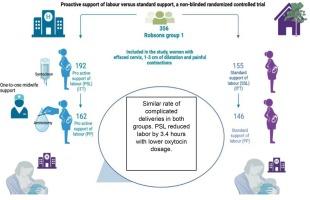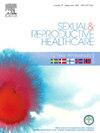潜伏期分娩的主动支持与标准支持-一项随机对照临床试验
IF 1.7
3区 医学
Q3 PUBLIC, ENVIRONMENTAL & OCCUPATIONAL HEALTH
引用次数: 0
摘要
目的产程潜伏期过长和总产程延长增加了产科干预和并发症的风险。我们探讨了主动分娩支持(PSL)与标准分娩支持(SSL)在潜伏期是否可以降低无产妇女的复杂分娩率。随机对照试验(RCT)。方法在挪威特隆赫姆圣奥拉夫大学医院进行一项单中心随机对照试验,纳入356例处于产程潜伏期、单胎妊娠、头位分娩和自然足月分娩的产妇。主要结局指标复杂分娩的复合率,定义为器械分娩、剖宫产(CS)、估计出血量(500 ml)、产时温度(38.00℃)、肩难产、会阴撕裂III级或IV级,或5分钟Apgar评分(7分)。结果我们发现复杂分娩的复合率无差异,分别为40% vs 34% (or = 1.3 (95% CI = 0.8-2.0), p值= 0.302),或复杂分娩的各个组成部分。在PSL和SSL组之间。PSL组产程持续时间和个体最大催产素用量均有所减少。PSL组和SSL组的阴道检查次数和转到新生儿重症监护病房的次数相似。PSL组更多的妇女接受硬膜外镇痛。结论潜伏期积极助产并不能降低复杂分娩的发生率,但能缩短产程,降低最大催产素用量。对于一些无产妇女来说,在不影响产妇或新生儿安全的情况下,积极支持分娩可能被视为一种替代选择,以防止长时间的分娩潜伏期。本文章由计算机程序翻译,如有差异,请以英文原文为准。

Proactive versus standard support of labor in the latent phase – A randomized, controlled clinical trial
Objective
Long latent phase of labor with subsequent prolonged total labor duration increases the risk of obstetric interventions and complications. We explored whether Proactive Support of Labor (PSL) compared to Standard Support of Labor (SSL) in the latent phase, reduces the rate of complicated deliveries in nulliparous women.
Design
Randomized, controlled trial (RCT).
Methods
A single-center RCT, at St. Olav’s University Hospital of Trondheim, Norway, including 356 nulliparous women in the latent phase of labor with a singleton pregnancy, cephalic presentation and spontaneous term onset of labor.
Main outcome measures
The composite rate of complicated deliveries, defined as instrumental delivery, caesarean section (CS), estimated blood loss >500 ml, intrapartum temperature >38.00 °C, shoulder dystocia, perineal laceration grade III or IV, or Apgar score <7 at 5 min.
Results
We found no difference in the composite rate of complicated deliveries, 40 % vs 34 % respectively, (OR = 1.3 (95 % CI = 0.8–2.0), p-value = 0.302), or the individual components of complicated deliveries, between PSL and SSL groups. In the PSL group, both the duration of labor and the individual maximum dosage of oxytocin were reduced. The number of vaginal examinations and transfer to neonatal intensive care unit in the PSL and SSL groups were similar. More women in the PSL group received epidural analgesia.
Conclusion
Proactive support of labor in the latent phase did not reduce the rate of complicated deliveries, but shortened labor duration, with lower maximum oxytocin dosage. Proactive support of labor may be considered as an alternative option for some nulliparous women to prevent a long latent phase of labor, without compromising maternal or newborn safety.
求助全文
通过发布文献求助,成功后即可免费获取论文全文。
去求助
来源期刊

Sexual & Reproductive Healthcare
PUBLIC, ENVIRONMENTAL & OCCUPATIONAL HEALTH-
CiteScore
2.70
自引率
5.60%
发文量
73
审稿时长
45 days
 求助内容:
求助内容: 应助结果提醒方式:
应助结果提醒方式:


